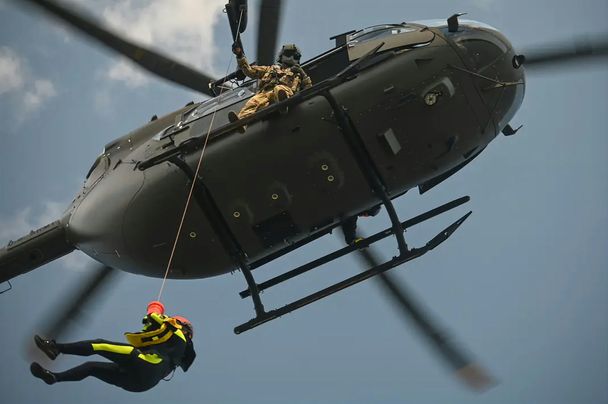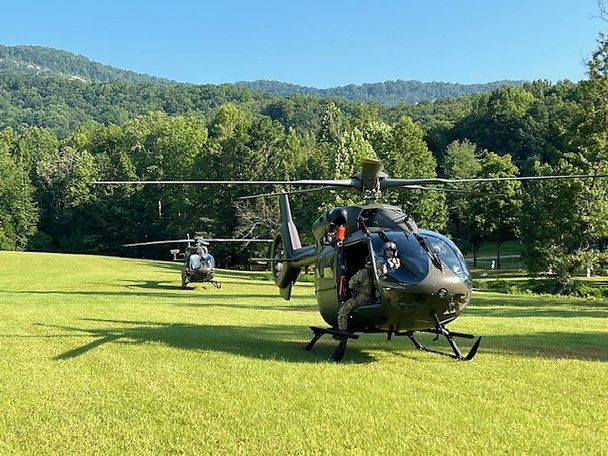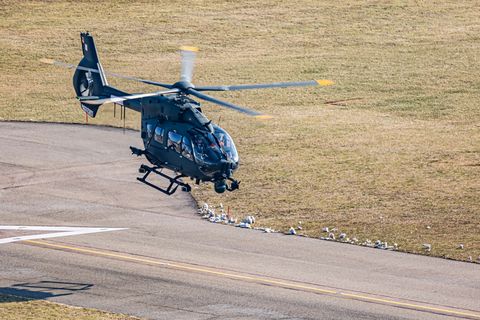Hurricane Helene relief efforts show the UH-72B Lakota is a force for good

Although Helene weakened from a Category IV hurricane after making landfall on Sept. 26, the storm stalled over the Blue Ridge Mountains for three days and unleashed its fury on several small mountain communities. Punishing winds, rain, and tornadoes, combined with unique aspects of mountain topography, led to torrential flooding and devastating landslides wiping entire towns off the map.
Helene caused more than 2,000 landslides in western North Carolina alone and was dubbed a once-in-1,000-year rainfall event by the National Weather Service. People watched as rivers burst their banks and washed their homes downstream leaving them stranded, in need of food, water, shelter, and relief supplies.
Completely inaccessible
“Things were really bad,” said Chief Warrant Officer 2, Kevin Deharo, a UH-72 Lakota pilot with the North Carolina National Guard. “Everywhere was cut off and completely inaccessible; there were down bridges, collapsed houses, and a lot of stranded elderly people and pets who needed our help.”
Deharo is part of Detachment 1, Bravo Company 2-151st Aviation Regiment and performs missions with the North Carolina Helicopter Aquatic Rescue Team (NCHART) when called upon. NCHART is a partnership between the National Guard, Highway Patrol, Emergency Management and local first responders, and after Helene hit, Deharo flew nearly 40 hours over a five-day span in the UH-72 Lakota performing critical search and rescue missions.

Priceless assets
Justin Graney, an official with the North Carolina Department of Public Safety, said that NCHART aviation teams have been performing rescues across the state for 20 years, but this recent effort following Helene in western North Carolina was the most robust aviation response in the state’s history.
“After a disaster, aviation assets are priceless and allow us to get critical commodities in areas devastated by a storm,” he said. “They either rescue folks from an aircraft using a static line [or] lower into the area and make a rescue.” In all, the NCHART team made 540 air rescues during Helene, 196 were conducted by hoist operations, he said.
Perfect operations when pushed to the limit
Chief Warrant Officer 3, John Seeger, a member of the South Carolina National Guard who serves as part of Alpha Company 2-151st Aviation Regiment, also flew missions in support of Hurricane Helene. Seeger said that his unit was tasked to do grid-search operations up and down valleys, and then hover or land at specific landing zones (LZ) to deliver supplies or rescue people in need of assistance. “The LZs for this mission were really tight - 45’ x 45’,” he said. “We not only had to think about how to land, but also how to get out. There were a lot of wind and obstacles in our way, including downed trees and power lines and we had to be precise in our execution.”
Seeger, who has flown the Lakota since 2020, said he and his crew performed 57 total rescues, including 12 pets, and delivered more than 1,000 kg. of supplies. “This mission was perfectly suited for the Lakota. We pushed it to its limit, and it handled things perfectly,” he said.

| 
|
A higher power margin
Staff Sgt. James Bailey, who flew with Deharo and served as the crew chief and hoist operator on the Lakota during hurricane relief efforts, said they frequently train for this mission. “We practice rescues in that area [of North Carolina] all the time,” he said. “How much we train enabled us to be absolutely prepared for whatever came our way.”
Deharo added that the helicopter performed exceptionally well in difficult circumstances and enabled the pilots to focus on the mission, rather than the aircraft. “I cannot say enough good things about how the platform performed during the mission,” Deharo added. “We operated in really tight areas and the platform gave us a good power margin to do what we needed to do. No doubt, [Lakota] helped us be a force for good in this terrible situation.”



